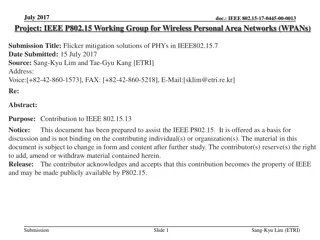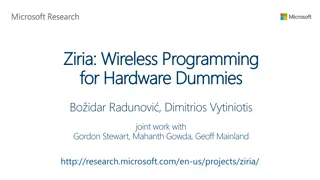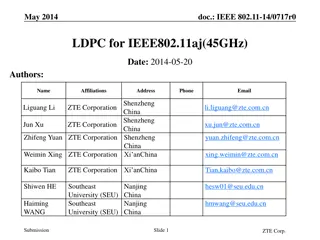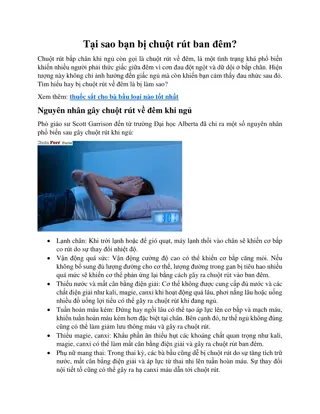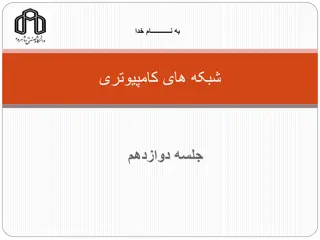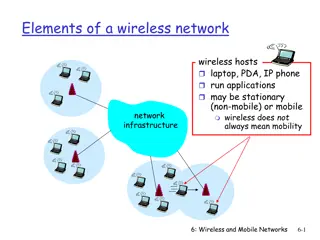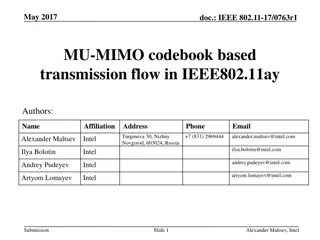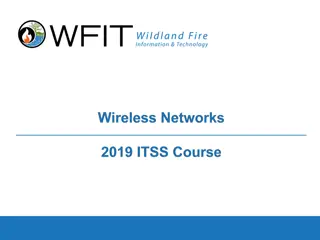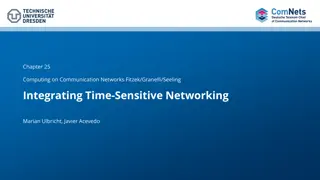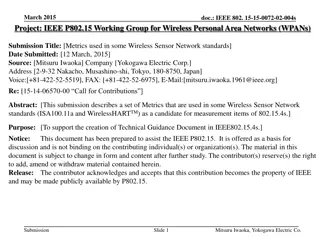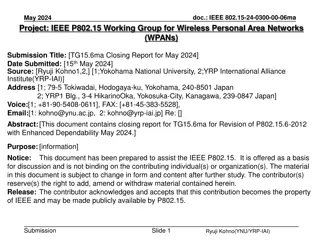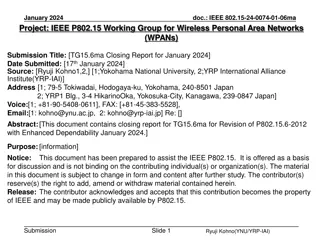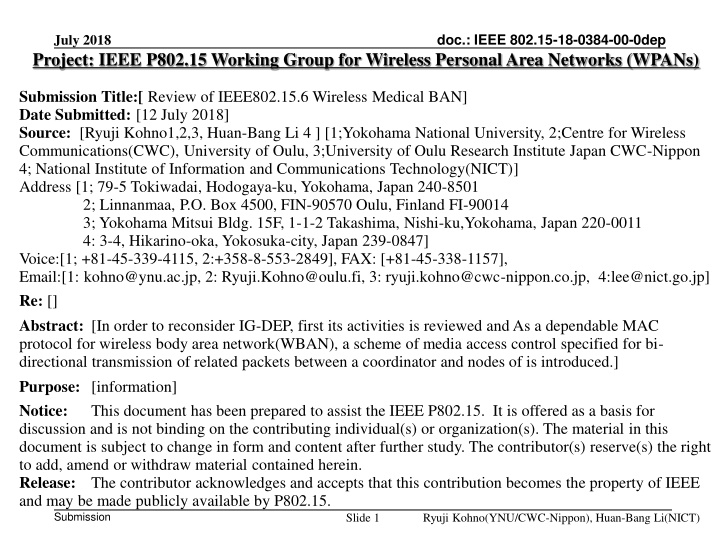
IEEE 802.15.6 Wireless Medical BAN Review
Explore the review of IEEE 802.15.6 Wireless Medical Body Area Network (BAN) protocol as presented in the document submitted by Ryuji Kohno and Huan-Bang Li. The submission delves into the activities of IG-DEP, dependable MAC protocol, and the application of wireless networks in medical and automotive sectors. Key agenda items include defining dependability in wireless networks, use cases, technical requirements, and a focus on the medical infrastructure platform. The document also touches on discussions surrounding possible amendments to IEEE 802.15.6.
Download Presentation

Please find below an Image/Link to download the presentation.
The content on the website is provided AS IS for your information and personal use only. It may not be sold, licensed, or shared on other websites without obtaining consent from the author. If you encounter any issues during the download, it is possible that the publisher has removed the file from their server.
You are allowed to download the files provided on this website for personal or commercial use, subject to the condition that they are used lawfully. All files are the property of their respective owners.
The content on the website is provided AS IS for your information and personal use only. It may not be sold, licensed, or shared on other websites without obtaining consent from the author.
E N D
Presentation Transcript
doc.: IEEE 802.15-18-0384-00-0dep July 2018 Project: IEEE P802.15 Working Group for Wireless Personal Area Networks (WPANs) Submission Title:[ Review of IEEE802.15.6 Wireless Medical BAN] Date Submitted: [12 July 2018] Source: [Ryuji Kohno1,2,3, Huan-Bang Li 4 ] [1;Yokohama National University, 2;Centre for Wireless Communications(CWC), University of Oulu, 3;University of Oulu Research Institute Japan CWC-Nippon 4; National Institute of Information and Communications Technology(NICT)] Address [1; 79-5 Tokiwadai, Hodogaya-ku, Yokohama, Japan 240-8501 2; Linnanmaa, P.O. Box 4500, FIN-90570 Oulu, Finland FI-90014 3; Yokohama Mitsui Bldg. 15F, 1-1-2 Takashima, Nishi-ku,Yokohama, Japan 220-0011 4: 3-4, Hikarino-oka, Yokosuka-city, Japan 239-0847] Voice:[1; +81-45-339-4115, 2:+358-8-553-2849], FAX: [+81-45-338-1157], Email:[1: kohno@ynu.ac.jp, 2: Ryuji.Kohno@oulu.fi, 3: ryuji.kohno@cwc-nippon.co.jp, 4:lee@nict.go.jp] Re: [] Abstract: [In order to reconsider IG-DEP, first its activities is reviewed and As a dependable MAC protocol for wireless body area network(WBAN), a scheme of media access control specified for bi- directional transmission of related packets between a coordinator and nodes of is introduced.] Purpose: [information] Notice: This document has been prepared to assist the IEEE P802.15. It is offered as a basis for discussion and is not binding on the contributing individual(s) or organization(s). The material in this document is subject to change in form and content after further study. The contributor(s) reserve(s) the right to add, amend or withdraw material contained herein. Release: The contributor acknowledges and accepts that this contribution becomes the property of IEEE and may be made publicly available by P802.15. Slide 1 Submission Ryuji Kohno(YNU/CWC-Nippon), Huan-Bang Li(NICT)
doc.: IEEE 802.15-18-0384-00-0dep July 2018 Review of IEEE802.15.6 Wireless Medical BAN Ryuji Kohno1)2)3), Huan-Bang Li4) 1) Yokohama National University, Japan 2) University of Oulu, Finland 3) University of Oulu Research Institute Japan CWC-Nippon, Co. Ltd. 4) National Institute of Information and Communication Technology, Japan Submission Slide 2 Ryuji Kohno(YNU/CWC-Nippon), Huan-Bang Li(NICT)
July 2018 doc.: IEEE 802.15-18-0384-00-0dep Agenda 1. Short Summary of IG-DEP Activities 2. Review of Previous Meetings 3. Definition of Dependability in Wireless Networks 4. Use Cases and Applications of Dependable Wireless 5. Focused Use case; Automotive Use Cases 6. Summary of Technical Requirement for Automotive 7. Technical Requirement for Automotive and UAV 8. Demand of Medical Infrastructure Platform of BAN, Cloud Networks and AI Data Mining Server and Repository 9. Review of IEEE802.15.6 for Medical WBAN 10.Discussion; Possible Amendment of IEEE802.15.6 Submission Slide 3 Ryuji Kohno(YNU/CWC-Nippon), Huan-Bang Li(NICT)
July 2018 doc.: IEEE 802.15-18-0384-00-0dep 1. Wireless BAN: Body Area Network Wearable BAN Implant BAN Tele-metering or sensing vital signs with various sensors ECG EEG Blood Pressure Heart Beat Body temperature Sugar rate Medical images And video Etc. Tele-control of Medical Equipment and Devices Pace Maker with ICD Wireless Capsule Endoscope Novel Concept Intelligent Network of Vital Sensors, eHR, Medical Robots etc. Submission Ryuji Kohno(YNU/CWC-Nippon), Huan-Bang Li(NICT) 4
July 2018 doc.: IEEE 802.15-18-0384-00-0dep 2. Standard of Medical Wireless Body Area Network(BAN);IEEE802.15.6 IEEE802 IEEE802.11 Wireless LAN IEEE802.15 Wireless PAN IEEE802.16 Wireless MAN 802.15.3 PHY for High Rate WPAN 802.15.4 PHY for Low Rate WPAN 802.15.5 WPAN Mesh Network 802.15.2 Coexistence between WPAN and WLAN 802.15.1 Bluetooth 802.15.6 Wireless Medical BAN 2012.2 Standard was Completed 802.15.3a Alternative PHY of 15.3 802.15.3b Maintenance of 15.3 802.15.3c PHY in Millimeter wave band 802.15.4a Low rate UWB PAN Alternative PHY of 15.4 2007.3 Standard Completed 802.15.4b Revision & Modification of 15.4 MAC 802.15.4c Chinese WPAN 802.15.4d Japanese WPAN Submission Slide 5 Ryuji Kohno(YNU/CWC-Nippon), Huan-Bang Li(NICT)
July 2018 doc.: IEEE 802.15-18-0384-00-0dep 3. Main Contributors at TG6 Casuh CEA-LETI CNU CSEM CUNY ETRI France Telecom Fujitsu Lab. Europe Fujitsu Lab. GE Global Research GE Healthcare IMEC Inha University KETI Korpa LG Electronics Meiji Univesity Mitsubishi Electric Research Labs, USA NICT NICTA NIST Olympus, USA Philips, USA Philips, EU Samsung Tensorcom Texas Instrument Thales Toumaz Technologies Yokohama National University Zarlink Semiconductor Asia Europe USA Submission Slide 6 Ryuji Kohno(YNU/CWC-Nippon), Huan-Bang Li(NICT)
July 2018 doc.: IEEE 802.15-18-0384-00-0dep 4. Overview of IEEE Std 802.15.6 IEEE 802.15.6 UWB PHY on-body HBC PHY on-body Narrow band PHY on-body & in-body Common MAC for all PHY Beacon-base- TDMA Group Superframe Priority support Non-beacon mode Frequency Selective 10-50MHz 125kbps- 2Mbps Modulation: GMSK & DPSK TX range: ~3m Bands: MICS,WMTS,ISM Data rate: ~ some Mbps Modulation:IR-UWB & FM-UWB TX range: ~3m Band: UWB band Data rate: ~10Mbps UWB: Ultra-wideband HBC: Human body communication Ryuji Kohno(YNU/CWC-Nippon), Huan-Bang Li(NICT) Submission Slide 7
July 2018 doc.: IEEE 802.15-18-0384-00-0dep 5. 15.6 User Priority Mapping Priority level Traffic designation Data type 7 Emergency or medical event report Data High priority medical data or network control 6 Data or management 5 Medical data or network control Data or management 4 Voice Data 3 Video Data 2 Excellent effort Data 1 Best effort Data 0 Background Data Submission Slide 8 Ryuji Kohno(YNU/CWC-Nippon), Huan-Bang Li(NICT)
July 2018 doc.: IEEE 802.15-18-0384-00-0dep 6. Three Channel Access Modes Channel access mode Time reference-based (superframe structure) Beacon Notes Coordinator sends beacon in each superframe except for inactive superframes. Coordinator establishes time reference but doesn t send beacon. There is not time reference. I Yes Yes II Yes No III No No Submission Slide 9 Ryuji Kohno(YNU/CWC-Nippon), Huan-Bang Li(NICT)
July 2018 doc.: IEEE 802.15-18-0384-00-0dep 7. Time-referenced Superframe w/ Beacon Clock and position of each access phase May obtain contended allocation for highest priority B2 B EAP1 RAP1 EAP2 RAP2 CAP MAP MAP One superframe EAP: exclusive access phase RAP: random access phase MAP: managed access phase CAP: contention access phase Submission Slide 10 Ryuji Kohno(YNU/CWC-Nippon), Huan-Bang Li(NICT)
July 2018 doc.: IEEE 802.15-18-0384-00-0dep 8. Main Features of the Three PHYs Frequency band (MHz) Data rate (kbps) Note Interference with other systems operate at the same bands Worldwide common band is 7.25 8.5 GHz Strong concern on the effect to implant devices 400, 600, 800, 900, 2400 NW-PHY 75.9 --- 971.4 6000-10600 3100-4800 UWB-PHY 390 --- 12600 HBC-PHY 21 164 --- 1312.5 Submission Slide 11 Ryuji Kohno(YNU/CWC-Nippon), Huan-Bang Li(NICT)
July 2018 doc.: IEEE 802.15-18-0384-00-0dep 9. Main Specifications of NB-PHY Modulations PLCP header /2-DBPSK, /4-DQPSK /8-D8PSK 420-450 GMSK GMSK /2-DBPSK, /4-DQPSK /8-D8PSK /2-DBPSK, /4-DQPSK /8-D8PSK /2-DBPSK, /4-DQPSK /8-D8PSK /2- DBPSK /4-DQPSK /2- DBPSK /4-DQPSK Frequency bands (MHz) Data rates (kbps) Number of channel Notes PSDU 75.9/151.8/ 303.6/455.4 Majority countries of /2- DBPSK 402-405 10 75.9/151.8/187.5 12 Japan /2- DBPSK 101.2/202.4/ 404.8/607.1 863-870 14 EU /2- DBPSK 101.2/202.4/ 404.8/607.1 North America, Australia 902-928 60 /2- DBPSK 101.2/202.4/ 404.8/607.1 950-958 16 Japan /2-DBPSK, 121.4/242.9/ 485.7/971.4 121.4/242.9/ 485.7/971.4 2360-2400 39 USA /2-DBPSK, 2400-2483.5 79 Worldwide Submission Slide 12 Ryuji Kohno(YNU/CWC-Nippon), Huan-Bang Li(NICT)
July 2018 doc.: IEEE 802.15-18-0384-00-0dep 10. Main Specifications of UWB-PHY Data rate (Mbps) Mode Modulation Waveform Chirp pulse, chaotic pulse, SRRC-like pulse, or others. IR-UWB (I) OOK 0.49 15.6 IR-UWB (II) DBPSK/DQPSK 0.49 15.6 Continuous-phase 2FSK (sub carrier) combined with FM FM-UWB 0.25 Gaussian (default) FM-UWB is an optional mode High QoS mode Hybrid Type II ARQ Submission Slide 13 Ryuji Kohno(YNU/CWC-Nippon), Huan-Bang Li(NICT)
July 2018 doc.: IEEE 802.15-18-0384-00-0dep 11. Main Specifications of HBC PHY HBC frequency band center frequency:21MHz (3dB_BW=5.25MHz Transmission method Frequency Selective Digital Transmission Data rate 164, 328, 656, 1312.5 kbps The electrode in contact with the body is used for transmitting or receiving an electrical signal through the body to a device Submission Slide 14 Ryuji Kohno(YNU/CWC-Nippon), Huan-Bang Li(NICT)
July 2018 doc.: IEEE 802.15-18-0384-00-0dep 12. World Wide UWB Regulations Submission Slide 15 Ryuji Kohno(YNU/CWC-Nippon), Huan-Bang Li(NICT)
July 2018 doc.: IEEE 802.15-18-0384-00-0dep 13. Specifications of High Band UWB Items Specifications Frequency band 7.25 10.25 GHz Average e.i.r.p. -41.3 dBm/MHz Peak e.i.r.p. Average unwanted radiation Peak unwanted radiation 0 dBm/50MHz -70 dBm/MHz -64 dBm/MHz Pulse rate ~ 50 Mpps Communication range ~ 3m Submission Slide 16 Ryuji Kohno(YNU/CWC-Nippon), Huan-Bang Li(NICT)
July 2018 doc.: IEEE 802.15-18-0384-00-0dep 14. Summary of IEEE802.15.6 Body area network (BAN) is considered as an core technology in supporting automatic medical monitoring and healthcare agilence services as well as consumer centric electronics. A standard, IEEE Std 802.15.6TM was completed and published in Feb. 2012. In which, Unified MAC and three PHY specifications are defined to support different applications. Commercial BAN products have been sold for medical healthcare for a human body in a world. In PHY, UWB-BAN is appropriate for high QoS use case. In MAC, hybrid contention base and free protocols is reliable to guarantee delay and throughput flexibly. Slide 17 Submission Ryuji Kohno(YNU/CWC-Nippon), Huan-Bang Li(NICT)
July 2018 doc.: IEEE 802.15-18-0384-00-0dep 15. Demands for BAN Extension 1. BAN for Car and Other Bodies beyond Human Body Reliable performance of medical BAN for human body could be widely applicable for remote maintenance of car body and other bodies in IoT/M2M use cases. Demands for More flexible and widely applicable BAN in cars, robotics, UAVs and others are increasing for autonomous remote sensing and controlling. current IEEE802.15 IG-Dependability 2. BAN-base Infrastructure Platform for Medical Healthcare BANs in end users are connected through Cloud Network and Edge Computer with AI Data Mining Server and Repository for medical healthcare platform by integration between ICT and data science. Enhanced dependability is required for end-to-end reliability and security. 3. BAN-base Universal Platform for Medical and beyond Medical Infrastructures Emergency for natural disasters and terrorism, smart city with reliable maintenance of cars, buildings etc. need common dependable platform, Submission Slide 18 Ryuji Kohno(YNU/CWC-Nippon), Huan-Bang Li(NICT)








